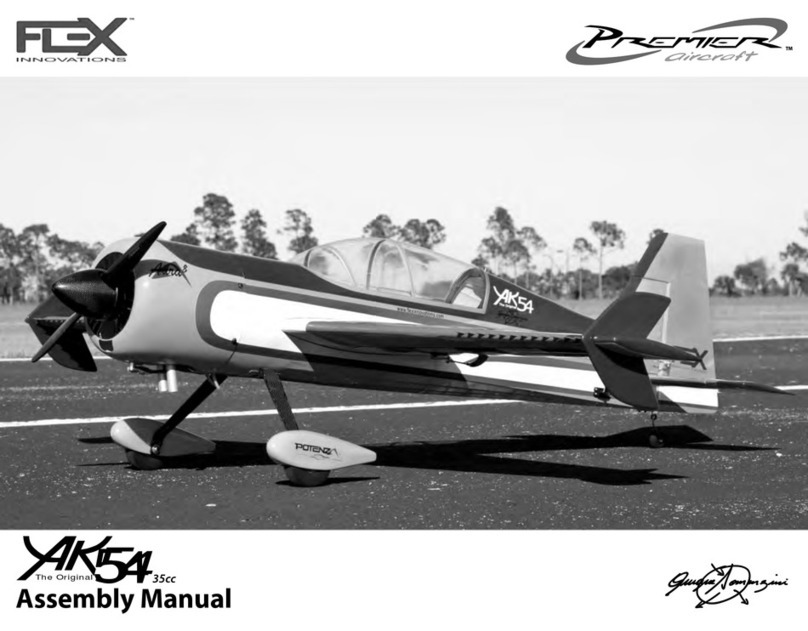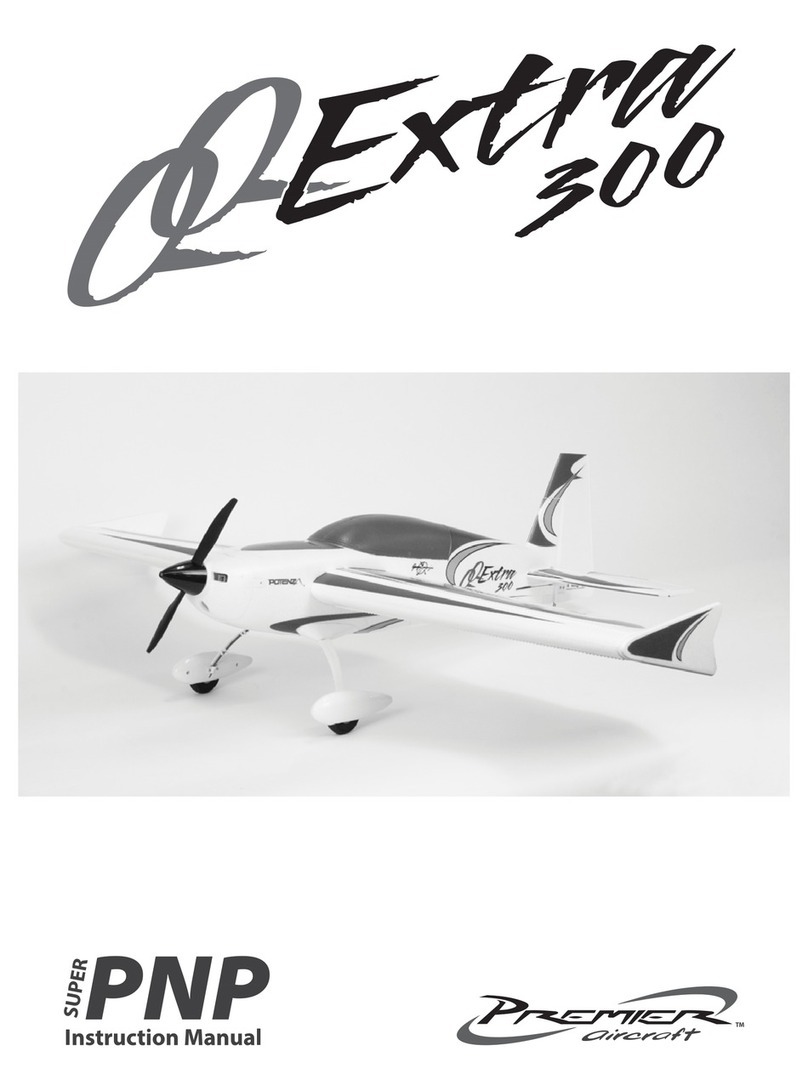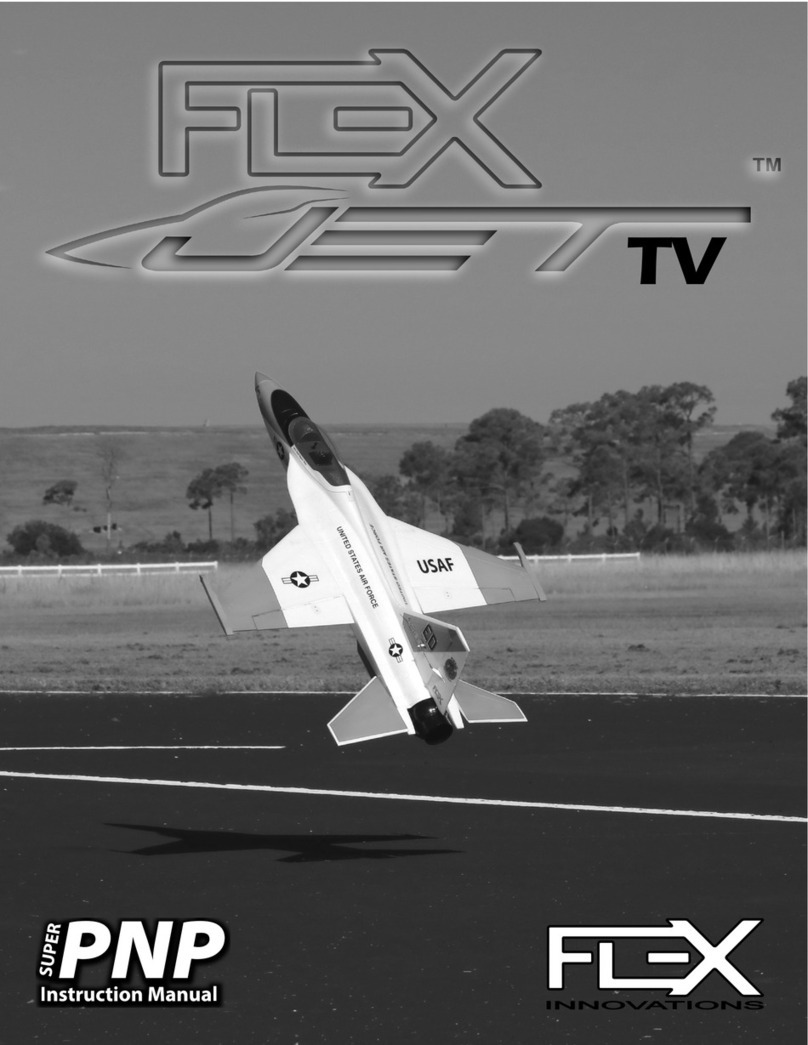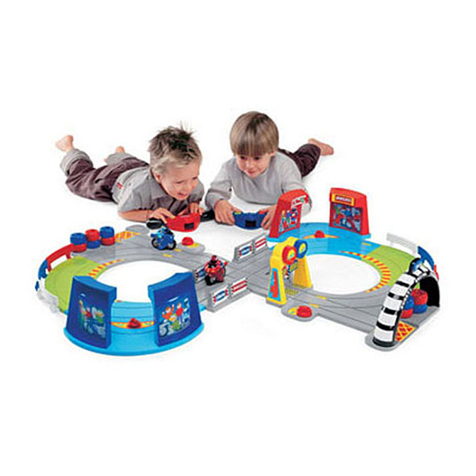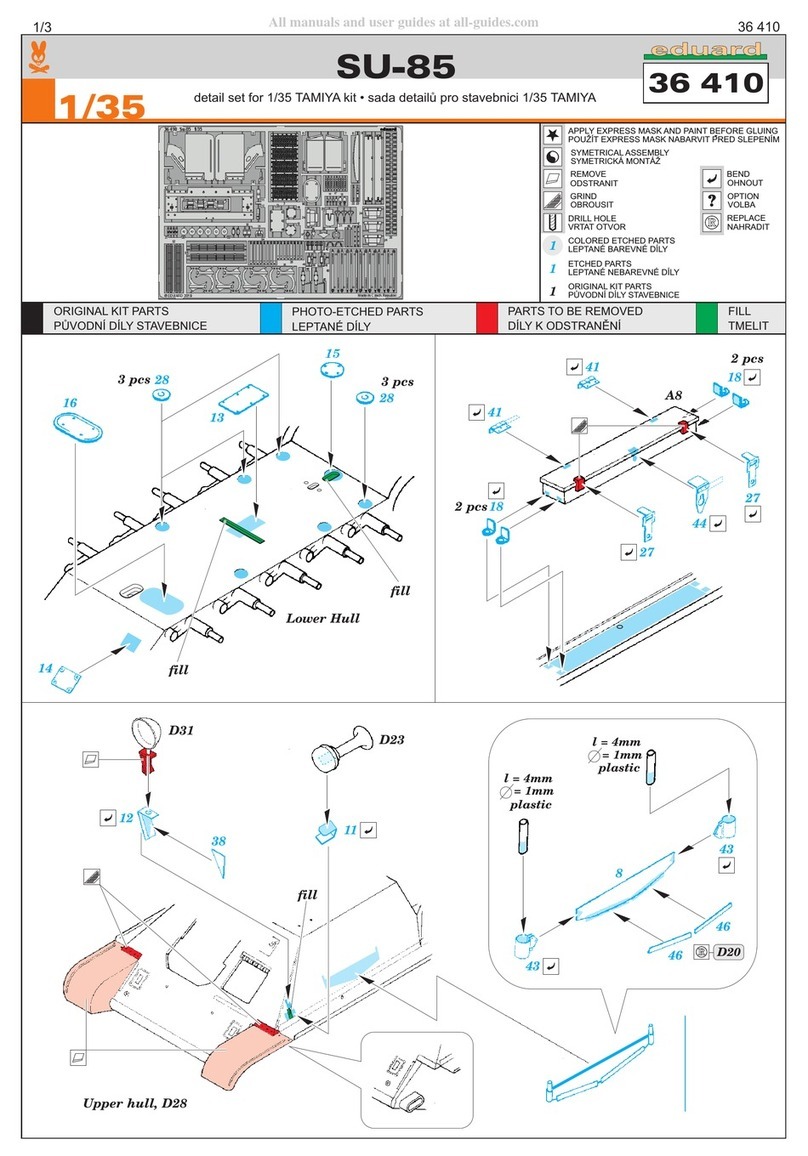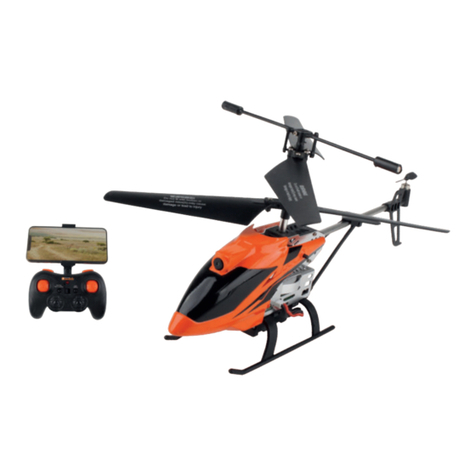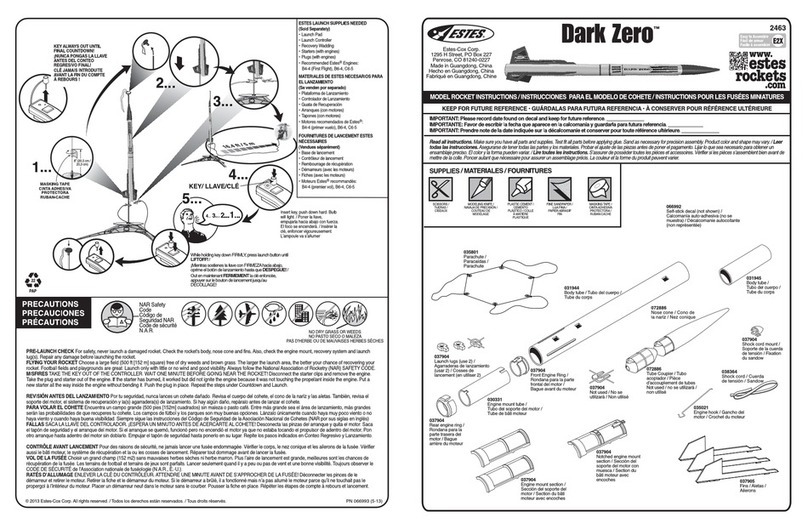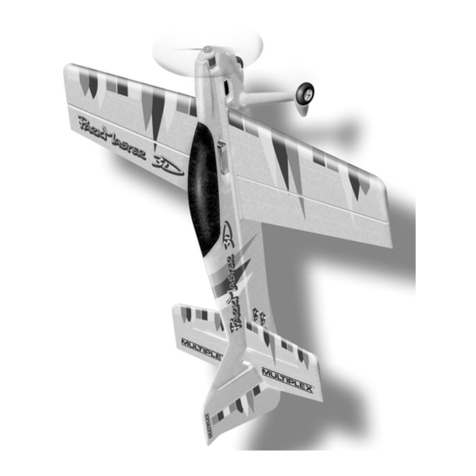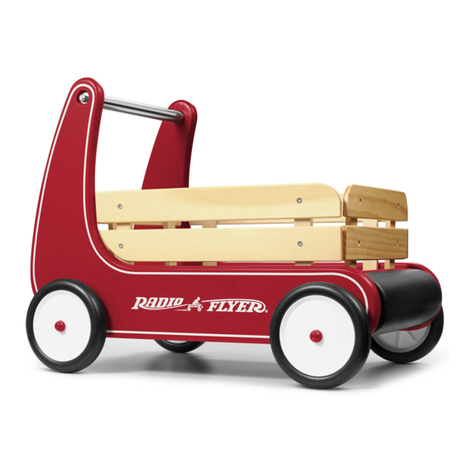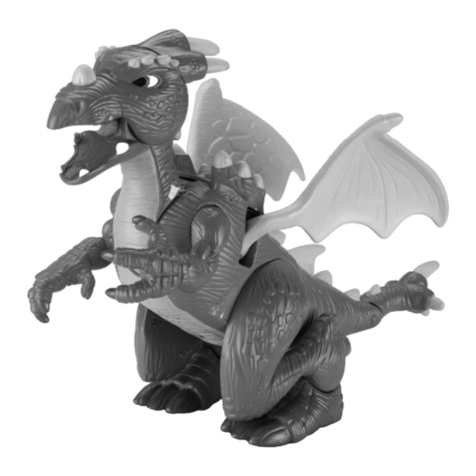Flex Cessna 170 User manual

DESIGNED BY:

TABLE OF CONTENTS
INTRODUCTION
The Cessna 170 and the Aura 8: the perfect combinaon!
The Cessna 170 is the evoluon and accumulaon of many years of
experience in the aerodynamic and electronic stabilizaon world. A perfectly
tuned airframe design, combined with today's most advanced control system
gives an unmatched ying experience.
Pilots will feel smooth, precise aircracontrol without any interference to
pilot inputs. The aircrawill y as if it were much larger, turbulent air will be
less noceable, rotaons will stop more precisely and landing will be easier
to execute. Flex Innovaons has tuned and matched both to their best
potenal, however, the Aura 8 programming capability allows total freedom
to the pilot to adjust (including seng ight modes that can turn it o). USB
rmware update capability allows you to enjoy and benet from the latest
features and advancements.
For the latest updates, features, addendums and more, before assembly,
please visit:
hp://wiki.exinnovaons.com/wiki/Cessna170
Low wing loading oers superb stability at slow speed.
Custom-tuned Aura 8 gyro stabilizaon system provides
the ulmate in stability and control
Powerful 60-sized motor provides the punch for
demanding tasks
High-precision digital servos with full metal gears
Light weight EPO foam is s and tough
Hollow carbon and plywood-reinforced wing is s and
lightweight
Custom-designed control horns to maximize control
geometry and performance
Bush wheels to handle rough terrain and enhance the
scale appearance
Introducon
Box Contents
Specicaons
Compleon Items
Baery Charging Guidelines
Special Language Denions
Important Informaon Regarding Warranty
Safety Warnings and Precauons
Low Voltage Cuto
Rudder Installaon
Tailwheel Installaon
Main Landing Gear Installaon
Propeller and Spinner Installaon
Horizontal Stabilizer Installaon
Main Wing Installaon
Night Cessna LED Connecons
Transmier Setup
Aura 8 AFCS
Receiver Installaon/Servo Connecons
Transmier Control Direcon Test
AFCS Sensor Direcon Test
Baery Installaon
Center of Gravity
Flying Your Cessna 170
Learning Use Flaps
Advanced "3D" Cessna/Aura Setup
Airframe Repairs
Replacing Servos
Servicing the Power System
AircraTroubleshoong Guide
Replacement Parts List
Oponal Parts List
Limited Warranty
AMA Safety Code
1
1
2
2
2
3
3
3
3
4
4
5
6
7
8, 9
10
11
.................................................................................
.................................................................................
................................................................................
.........................................................................
.........................................................
........................................................
.................................
.................................................
........................................................................
.......................................................................
....................................................................
....................................................
................................................
...................................................
..................................................................
.....................................................
.................................................................................
............................................................................................
...............................................
........................................................
....................................................................
................................................................................
...................................................................................
..........................................................................
................................................................................
.......................................................
....................................................................................
....................................................................................
..................................................................
.............................................................
..........................................................................
.................................................................................
..................................................................................
...................................................................................
12
12, 13
14
15
16
16
17
18
18
19
19
20
21, 22
23
23
24
25
1
BOX CONTENTS

COMPLETION ITEMS
Potenza 60L 540 Kv Brushless
Outrunner Motor (FPZM1060L)
HobbyWing SkyWalker 80A ESC
with 5V/8A External BEC
(FTVHWBQ8012EB)
Potenza DS33 and DS19 Digital
Servos (FPZDS33 & FPZDS19)
Aura 8 Advanced Flight Control
System (FPZAURA08ZZC17)
16 x 6 Electric SR Propeller
(FPMP1606E)
3300-5000mAh 6S 22.2V 40C+ LiPo
3300-5000mAh 5S 18.5V 30C+ LiPo
3300-5000mAh 4S 14.8V 30C+ LiPo
(FPZB40006S40), (FPZB50006S40)
(FPZB40005S40)
(FPZB50004S40)
Hot Aeroba�cs:
Sport Aeroba�cs:
Sport/Scale:
6-Channel Computer Transmier
DSM2/DSMX Remote Receivers (x2)/
SRXL/S.Bus Futaba/Graupner HOTT
JR XBus/JeUDI
6+ Channel RX (any brand)
NEEDED TO
COMPLETE
NEEDED TO
COMPLETE
NEEDED TO
COMPLETE
INCLUDED!
INSTALLED!
INSTALLED!
INSTALLED!
INSTALLED!
SPECIFICATIONS
86.7 in. (2204mm)
60.1 in. (1544mm)
Standard: 8.66lb (3.93kg)
Night: 9.63 lb (4.37kg)
RTF with 6S 4000mAh baery installed
RTF with 6S 4000mAh baery (motor) &
3S 2200mAh (Night LEDs) baery installed
1,094 sq. in.
(70.6 sq. dm.)
BATTERY CHARGING GUIDELINES
The assembly of the Cessna 170 can be accomplished in
less than one hour. Prior to assembling the airplane, it is
advisable to charge your baery so that you are ready
to begin setup upon compleon of the assembly of your
model.
We recommend the use of an advanced LiPo balancing
charger, such as our Potenza C80 MulChemistry Touch
Screen AC/DC balancing charger for your baeries to
get the maximum performance and lifespan.
Our airplanes are designed around our Potenza LiPo
baeries, and we recommend the Potenza 4S 5000mAh
40C LiPo, the 5S 5000mAh 40C LiPo, and the 6S
4000mAh 40C LiPo in the Cessna 170 based on our
extensive tesng and development. These baeries
feature an EC5 connector, so no soldering is required for
use in your Cessna.
All are available at www.exinnovaons.com or at your
local retailer.
WARNING
FOLLOW ALL INSTRUCTIONS PROVIDED BY YOUR
BATTERY AND CHARGER MANUFACTURER. FAILURE
TO COMPLY CAN RESULT IN FIRE.
2
FPM317014
FPM317015
FPM317016
FPM317018
FPZB40006S40
FPZB50006S40
FPZB50006S60
FPZB50005S40
FPZB50004S40
FPZC80
FTVHWBQ2006
FPZA1010
Cessna 170: Float Set & Struts w/ LED Light
Cessna 170: Fixed Slat Set
Cessna 170: Snow Ski Set
Cessna 170: Key Chain Camera Mount
Potenza 6S 4000mAh 40C Li-Po Baery
Potenza 6S 5000mAh 40C Li-Po Baery
Potenza 6S 5000mAh 60C Li-Po Baery
Potenza 5S 5000mAh 40C Li-Po Baery
Potenza 4S 5000mAh 40C Li-Po Baery
C80 Mul-Chemistry Touch Screen AC/DC Charger
Hobbywing ESC Programming Card
Potenza Mul-Funcon Digital Baery Analyzer
OPTIONAL ACCESSORIES
Receiver

The following terms are used throughout the product literature to indicate various levels of potenal harm when operang this product:
SPECIAL LANGUAGE DEFINITIONS
ATTENTION
WARNING
AGES 14+
NOTICE:
CAUTION:
WARNING:
Procedures, which if not properly followed, create a possibility of physical property
damage AND a lile or no possibility of injury.
Procedures, which if not properly followed, create the probability of physical
property damage AND a possibility of serious injury.
Procedures, which if not properly followed, create the probability of property
damage, collateral damage, and serious injury OR create a high probability of
serious injury.
Read the ENTIRE instrucon manual to become familiar with the features of the product
before operang. Failure to assemble or operate the product correctly can result in damage
to the product, personal property, and cause serious or fatal injury.
All instrucons, warranes and other collateral documents are subject to change at the sole
discreon of Flex Innovaons, Inc. For up-to-date product literature, please visit our website
at www.exinnovaons.com and click on the Cessna 170 and Aura 8 product pages.
This product is not intended for use
by children under 14 years without
direct adult supervision.
IMPORTANT INFORMATION REGARDING WARRANTY
SAFETY WARNINGS AND PRECAUTIONS
Please read our Warranty and Liability Limitaons secon before building this product. If you as the Purchaser or user are not prepared
to accept the liability associated with the use of this Product, you are advised to return this product immediately in new and unused
condion to the place of purchase.
LOW VOLTAGE CUTOFF
Protect yourself and others by following these basic safety guidelines.
1. This manual contains instrucons for safety, operaon and maintenance. It is essenal to read and follow all the instrucons and
warnings in the manual, prior to assembly, setup or use, in order to operate correctly and avoid damage or serious injury.
2. This model is not a toy, rather it is a sophiscated hobby product and must be operated with cauon and common sense. This product
requires some basic mechanical ability. Failure to operate this product in a safe and responsible manner could result in injury or damage
to the product or other property.
3. This model must be assembled according to these instrucons. Do not alter or modify the model outside of these instrucons
provided by Flex Innovaons, Inc. as doing so may render it unsafe and/or unyable. It is your responsibility to ensure the airworthiness
of the model.
4. Inspect and check operaon of the model and all its components before every ight.
5. If you are not an experienced pilot or have not own a high-performance model before, it is recommended that you seek assistance
from an experienced pilot in your R/C club for your rst ights. If you're not a member of a club, the Academy of Model Aeronaucs
(AMA) has informaon about clubs in your area whose membership includes experienced pilots.
6. Keep the propeller area clear from such items as loose clothing, jewelry, long hair, or tools as they can become entangled. Keep your
hands and body parts away from the propeller as injury can occur.
7. Never y in visible moisture, or submerge the airplane or any of its electronic components in water. Permanent damage to electronic
components may occur, or corrosion of components may lead to intermient failures.
LiPo baeries have a nominal (rated) voltage of 3.7V per cell, and fully charged, reach 4.2V per cell. Baeries are designed to be
discharged below the nominal voltage, however, if they are discharged below 3.0V per cell, damage will occur and the pack will lose
capacity. For best long term baery life, set a mer and land aer a me that leaves approximately 15% of the baery's capacity
remaining.
Low voltage cutois a feature that is built into the Hobby Wing SkyWalker 80A ESC that is designed to protect the connected baery
from being discharged too far and causing permanent damage to the cells. Circuitry within the ESC will automacally detect when the
input voltage from the baery pack reaches below 3.15V per cell (average) and will remove power to the motor, but sll deliver power
to the servos so that a safe landing may be made. If the motor begins to lose power rapidly during ight, the LVC has sensed that the
total voltage of the pack has dropped blow 3.15V per cell average, and the airplane should be landed immediately.
3

RUDDER INSTALLATION
Required Tools and Fasteners: Medium CA
2mm Hex Driver
4
1.
2.
3.
4.
5.
Connect the rudder clevis to the innermost hole in the control horn. Slide the clear tubing over the clevis to secure it in place.
Aer assembly is complete, and your receiver is bound and transmier properly set up, center the rudder by turning the clevis
in or out as needed. Use the rudder counter balance and xed poron of the vercal n for reference. Do NOT use trim or sub-
trim.
The rudder comes pre-hinged to a small secon of vercal n. Test t the rudder and n secon onto the fuselage. Remove it from the
fuselage once t is conrmed.
Lay the fuselage on its side, and using medium CA (foam-safe is not required), apply an adequate amount to the fuselage. Press the rudder and
vercal n secon into the fuselage, being sure to wipe away any excess CA.
Secure the lower plasc support in place by threading an M3x10 hex head self-tapping screw through the boom of the plasc part in the
fuselage. Do not fully ghten, as you can cause the rudder to bind. A small amount of play is needed here.
Allow me for the CA to dry, and once dry, check for proper rudder movement. Be sure the rudder moves freely with lile to no binding.
Press the tailwheel wire into the plate on the boom of the rudder. Lay the tailwheel plate over the wire, and secure it in place with two
M3x10 hex head self-tapping screws.
5.
3 - M3x10 Hex Head Self-Tapping Screw

MAIN LANDING GEAR INSTALLATION
Required Tools and Fasteners:
#1 Phillips Screwdriver
1.5mm Hex Driver
Slide an M5 spacer over the landing gear wire.
Slide a main wheel over the landing gear wire, followed by a lock collar. Add a drop of blue thread lock to the set screw, and secure it in place.
Repeat for the other wheel.
4 - M3x10 Hex Head Self-Tapping Screws
2 - M5 Lock Collars, with Set Screws
2 - M5 Spacer
Push the landing gear wire into the boom of the fuselage. Orientaon of the wire landing gear does not maer, however, the plasc wire
covers are direconal. You should have more material AFT of the landing gear wire. Insert the plasc landing gear keeper aer the landing gear,
nong orientaon. The plasc part will sit ush in one orientaon, but in the wrong direcon, may not sit ush.
Secure the plasc landing gear plate into the fuselage using 4 M3x10 self-tapping hex head screws. Do not overghten.
1.
2.
1.
2.
5
2mm Hex Driver
1.5mm Hex Driver

PROP ADAPTER, PROPELLER AND SPINNER INSTALLATION
6
1.
2.
3.
4.
5.
Required Tools and Fasteners: 3 - M3x9 Hex Head Machine Screws
1 - M3x30 Phillips Head Machine Screw
1 - Prop Washer
1 - Propeller Nut
2.5mm Hex Driver
#1 Phillips Screwdriver
Adjustable Wrench
Blue Thread Lock
Locate the bolt-on prop adapter for the motor. Apply blue thread lock to each of the three M3x9 hex head machine screws, and secure the prop
adapter to the motor. Make sure that the propeller adapter seats fully against the motor face, and is concentric with the motor sha.
Install the spinner backplate onto the motor sha. Ensure that it is fully seated.
Install the propeller with the convex surface facing forward. The propeller size numbers are printed on the front face of the prop and should
orient forward.
Slide the prop washer on the shawith the widest face a, and ghten the prop nut.
Install the spinner cone, and ghten the M3x30 Phillips Head screw using a #1 Phillips screwdriver. Do not apply blue thread lock and do not
over ghten.
Note: It is important to check the rear motor shacollar and set screw for thread lock before rst ights. If no thread lock is found, remove the
set screw, add blue thread lock, and re-secure. It is always a good idea to check all hardware connecons every few ights to ensure they stay
ght.
Note: Do not complete transmier, receiver and/or Aura setup with the propeller installed.

HORIZONTAL STABILIZER INSTALLATION
Required Tools and Fasteners: Clear Tape (4 Strips)
Insert the horizontal stabilizer tube into one of the horizontal stabilizer halves.
Slide the tube through the hole in the fuselage, being sure to orient the control horn towards the boom of the airplane. Do not
force it into place.
Slide the other stabilizer half onto the tube, being sure to index the elevator joiner tabs into one another. Do not force it into
place.
Apply 4 pieces of clear tape to the joint between the stabilizer and the plasc mounts. Be sure to apply tape to both the top and
boom sides of the stabilizer.
Aach the clevis to the elevator control horn in the innermost hole. Slide the clear tubing over the clevis to secure it in place.
1.
2.
3.
4.
5.
7

MAIN WING INSTALLATION
Required Tools and Fasteners: 2.5mm Hex Driver
Insert the main wing tube into one of the main wing halves.
Slide the tube through the hole in the fuselage. Make any necessary servo or light connec�ons (reference Night LED Connec�ons page if you
have purchased the Night Cessna). Note that the aileron and flap extensions are marked accordingly. Slide the wing fully into the plas�c
mounts, while taking special care to prevent any wires from being pinched when installing the panel.
Slide the other wing half onto the tube, and make any connec�ons as completed in the previous step. Fully seat the wing into the plas�c
mounts in the fuselage. Do not force it into place.
Secure each wing panel to the fuselage using 2 M3x25 hex head machine screws. Don't over �ghten.
1.
2.
3.
4.
8
4 - M3x25 Hex Head Machine Screws
4 - 6mm Strut Retaining Pins
4 - Strut Retaining Pin Keepers

MAIN WING INSTALLATION (CONTINUED)
9
Note which wing strut goes to each wing panel, and which end goes to the wing and to the fuselage The struts are labeled R and
L at one end of the strut. Also note that there are two dierent strut retaining pins; one that is shorter (A) and one that is longer
with a "D" shaped head (B). Pin A goes to the fuselage side, and Pin B goes to the wing side of the strut.
Insert a strut retaining pin through the end of the strut AND the mount in the wing. Slide a retaining pin keeper through the hole
in the retaining pin to secure it in place.
Repeat step 6, but for the plasc mount in the boom of the fuselage. The strut goes ABOVE the mount in the fuselage. Note
that for faster eld assembly, it is recommended to leave the strut aached to the wing panel, and only remove it from the
fuselage. The strut will lay at on the wing for storage.
Conrm the linkage locaons in the servo arm and control horn for both aps and ailerons, referencing the images below. Adjust
as necessary. Note that the ap servo will NOT be centered when the ap is in the up posion. This is proper, and intenonal in
5.
6.
7.
8.
FLAP AILERON
MAIN WING CONTROL LINKAGE SETUP
1.
2.
A - Fuselage Side B - Wing Side
Note: Aileron Differen�al has been tuned with Aura

NIGHT CESSNA LED CONNECTIONS
10
If you have purchased the Night version of the Cessna, this page will cover all LED light connecons. If you did not purchase the night version, skip
ahead to the next page.
In order to power the internal Night LED lights (not wing p or landing lights) you will need to use a seperate 3S Lithium-Polymer baery. We
recommend the Potenza 3S 2200mAh 40C Li-Po (FPZB22003S40). Average current draw for the lighng system is 2.2A/h.
1.
2.
3.
4.
5.
There are two connecons for each wing panel, one at the leading edge, and one at the trailing edge of the wing. Connect the one at the
trailing edge to the installed JST extension. Route the connector at the leading edge through the hole in the fuselage and plug into the LED
controller directly.
If using the oats with lights, connect each JST for the oat set to the LED controller in the fuselage. Route the leads through the cooling hole
in the boom of the fuselage. Secure the wire to the at strut and fuselage using water proof tape.
The fuselage LED strip is pre-connected to the LED controller for you. Should it become disconnected, connect it to one of the four JST
connectors on the LED controller.
Connect the balance tab (JST-XH) of any 3-Cell (12V DC) Li-Po baery (greater than 1300mAh, and 20C) to the balance tab adapter on the LED
controller. When connected, the lights are automacally powered. Turn to the LED lights o, disconnect the baery from the LED controller.
The LED controller defaults to a non-ashing mode. It has dierent ashing modes, and dierent ashing speeds available. Simply select the
speed or mode by pressing the buon(s) on the LED controller unl a desired seng is reached.
LED Controller
Two Wing Connecons
Float Connecon

11
TRANSMITTER SETUP
WARNING
DO NOT ATTEMPT RADIO SETUP WITH PROPELLER INSTALLED. INADVERTENT POWER UP COULD CAUSE PERSONAL INJURY.
TRANSMITTER SETUP GUIDE
End Points* Aileron/Elevator/Rudder
Throle
125%
100%
Sub Trim Veried at zero, sub-trim not allowed
Trim Levers Veried at zero
CH. 5 (Gear) Assigned to a 3-posion switch
CH. 6 (AUX1) Assigned to a 3-posion switch OR Flap System
If using ap system, assign 100%, 0%, -100%
Begin by starng with a freshly reset and new model memory in your transmier. Make ONLY the changes shown in the Transmier Setup Guide.
The Aura 8 on the Cessna 170 defaults to 3 ight modes that are switched via CH5/Gear in your transmier. You may need to reassign CH5/Gear to
a 3-posion switch. Consult your radio manual for direcons on channel assignment.
Reversing Ail/Ele/Rudder set to Normal
Thro/Flap depends on transmier manufacturer
Timer Set to 4:00 for inial ights
Descripon of Pre-Loaded Aura Flight Modes (FM)
FM 1:
FM 2:
FM 3:
Flight Control system is o. Rates are set for general ight
(same as FM 2). Exponenal is tuned for comfortable ight.
Rudder to aileron and rudder to elevator mix acve.
Flight Control system is on. Gains are moderate and tuned
for comfortable feel/best performance. Rates are set for
general sport ying, and expo is tuned for comfortable
ight. Rudder to aileron and rudder to elevator mix acve.
Flight Control system is on. Gains are moderate and tuned
for comfortable feel/best performance. Rates are set for
aggressive ying, and expo is tuned for comfortable ight.
Rudder to aileron and rudder to elevator mix acve.
Note: Rudder sck movement will also move ailerons and elevator.
This funconality is NORMAL.
Each of the modes has been tuned by our team to oer a solid start.
Because tastes in control feel are unique, if changes in rates and
expo are needed, adjustments should be made through the Aura 8.
Changes in gain value can only be made via Master Gain, or through
the Aura Cong Tool (Windows Applicaon).
AURA FLIGHT MODE REFERENCE
Aura 8
Rate Setup
Aileron
Elevator
Rudder
Mode 1 Mode 2 Mode 3
Aileron
Elevator
Rudder
Aura 8
Expo Setup
Mode 1 Mode 2 Mode 3
70% 100%
45% 45% 100%
100% 100% 100%
30% 10% 15%
30% 15% 40%
40% 35% 35%
CONNECTING BATTERY/ARMING ESC
Observe the following procedures to safely power up your model aer
it has been bound. Ensure propeller is removed unless sequence is
followed to power up before ight.
1.
2.
3.
4.
Lower the throle sck and trim to their lowest seng and turn
on the transmier. Wait for your transmier to indicate the RF
signal is being broadcast before proceeding.
If a baery is connected to the ESC with the throle fully open
on the acve transmier, the ESC will enter into programming
mode. If this occurs, simply disconnect the baery, lower the
throle, and reconnect the baery.
Ensure the rudder, elevator and aileron scks are centered.
With the airplane on a solid surface, connect the baery to the
ESC and wait. The ESC will emit a series of audible tones during its
inializaon process.
The ESC will emit a short, nal tone sequence indicang that the
ESC is now armed, and that the motor will spin in response to
throle sck movement.
When making adjustments to linkages, transmier sengs, or the
Aura 8 ight control system, REMOVE THE PROPELLER to guard
against accidental spool up.
WARNING
Hold aircrasecurely when connecng the ight baery before
ight. Always ensure that the propeller is clear of any and all
objects, as they may become entangled.
CAUTION
Always connect the baery when the throle and
throle trim are in the cut-oposion.
70%
*Note: JR Mode B Users set Throle, Aileron, Elevator, Rudder and Gear Travels to 88%
Note: These are for reference only. DO NOT put these values into your transmier.
WARNING
For large (greater than 5%) changes in expo, or dual rates, it is highly
recommended to reset all expos and rates to default in the transmier,
and tune through the Aura Cong Tool.
The Aura Cong Tool can be used on any Windows-based PC or Tablet,
and can be downloaded at the following address:
www.exinnovaons.com/arcles.asp?ID=257

AURA 8 AFCS
12
Works conveniently with all major radio systems
Accepts signals from DSM Satellite(s), Spektrum SRXL,
Futaba S.Bus, Graupner Ho(Sum D of 8), JR XBus (Mode
B), JeUDI12 (standard), PPM Stream, or any brand of
receiver via male to male servo connecons*
Expertly tuned and ready to use
USB port allows loading model conguraons, user
programming, and rmware updates (cable included)
Flexible and extensive programming through PC
3 ight modes in Aura allow precise or aggressive sengs,
or gyro oto be selected in ight
3-axis gyro ulized in Cessna 170 programming
Powerful 32-bit processor and 6 axis sensor for future
updates and re-use
The Aura 8 advanced ight control system installed in your Cessna 170 is a
giant leap forward in aircraight control system technology. Compable
with virtually every receiver on the market today via PWM connecons,
the Aura features special conguraon for DSM systems via remote
receiver connecon, and serial data connecon for Futaba S.Bus, Spektrum
SRXL, Graupner HOTT (Sum D of 8), JR XBus (Mode B), and JeUDI12
(standard) systems.
The Aura 8 advanced ight control system in your Cessna 170 has been
pre-tuned for ease of use, eliminang many hours of seng gains. For the
latest Aura features, programs, transmier downloads, and instrucons,
please visit www.exinnovaons.com/aura
The Aura is programmable through any Windows based computer, and
every axis has independent gain adjustment and by each ight mode. All
dual rate, expo, travel, and assignable mode programs are adjusted inside
the Aura through the PC applicaon. Anassignable master gain that is OFF
by default can be enabled by the Aura applicaon. If desired, assign it to
CH 8/AUX 3 on a proporonal dial or slider.
By default, CH5/Gear is used to select the 3 ight modes by 3 posion
transmier switch. *Visit hp://wiki.exinnovaons.com/wiki/Aura for the latest
Aura-related product informaon.
RECEIVER INSTALLATION/SERVO CONNECTIONS
DEFAULT AURA CONNECTIONS
S1
S2
S3
S4
S5
S6
S7
S8
Throle (ESC/BEC)
LeAileron
Right Aileron
Elevator
Rudder
LeFlap
Right Flap
Float Rudder
For Je/UDI users, please visit hp://wiki.exinnovaons.com/wiki/Aura/JeUse for more informaon.
For FrSky Taranis users, please visit hp://wiki.exinnovaons.com/wiki/Cessna170 for more informaon.
For Graupner users, please visit hp://wiki.exinnovaons.com/wiki/Aura/GraupnerHoUse for more informaon.
Aura will Auto-Detect modern data-linked receivers. The advantage of using a modern data-linked receiver is the ability to have 4 addional gyro-enabled
outputs to servos (total of 8 outputs), as well as wiring simplicity versus tradional PWM connecon types. To connect a modern data-linked receiver,
follow the steps on this page, then skip ahead to page 14.
For tradional PWM receivers (male to male servo leads for each channel), refer to the connecon diagram on page 13.
Aura will Auto-Detect these modern data-linked receivers:
Spektrum Remote Receivers (2 required for the Cessna)
Spektrum SRXL
Futaba S.Bus
JR XBus, Mode B
Graupner HOTT, Sum D of 8*
JeUDI12* (Standard)
Note: When using S.Bus, Aura reverses the throle direcon. It is
therefore NOT necessary for Futaba S.Bus users to reverse the
throle IF the throle/ESC is leplugged into the Aura.
Supported Modern Data-Linked Receivers
Connecng Your Receiver to Aura
- +
Aura
Polarity
Spektrum Remote Receivers
1.
2.
3.
4.
All Other Data-Linked Receivers
1.
2.
3.
4.
5.
Connect (2) Spektrum Remote Receivers to Mini Port 'A' and Mini Port 'B' at
the top of the Aura case.
To bind a DSMX Spektrum Remote Receiver connecon, insert a bind plug into
Aura Port S8.
To bind a DSM2 Spektrum Remote Receiver connecon, insert a bind plug into
Aura port S1 AND S8.
Power up the model, and the remote receivers should begin to ash, indicang
they are ready to bind. Bind from here as recommended in your transmier
manufacturer's instrucons.
Once bound (indicated by each remote receiver showing a solid orange LED),
Aura will begin the Auto-Detect process, searching for a valid control signal,
indicated by sweeping LEDs on the Aura. Once found, you will see solid orange
(power and calibrated sensor) and solid green (valid receiver data) LEDs,
indicang the Aura is in its ight-ready state.
Mount your receivers using double sided foam tape, or hook and loop tape.
Consult your receiver manual for proper mounng orientaons.
For JR DMSS, Graupner Hoand Je, consult your radio documentaon and
program the transmier/receiver to output the correct digital data format as
listed above. (Spektrum and Futaba typically always output the digital data
stream.
Bind your transmier and receiver per your manufacturer's instrucons.
Connect the included male to male extension to the receiver's data port (ex:
S.Bus) and connect to servo port 'B' on the face of the Aura. Refer to your radio
manufacturer's instrucons for specic informaon on appropriate serial port
connecons and system sengs.
With the transmier powered, power up the aircra. Aura will search
(sweeping LEDs) and lock onto the signal. You will then see solid orange (power
and calibrated sensor) plus solid green (valid radio source), and have control of
the model.
Mount your receiver using double sided foam tape or hook and loop tape.
Consult your receiver manual for proper mounng and antenna placement.
You can also use a PPM (8ch, Negave, Approximately 22ms Frame) connecon in Port B, but it
will not auto-detect, and will need to be set in the Aura Cong Tool (Windows Applicaon)

13
If you are using a digital receiver connecon, and have completed the steps on page 12, skip ahead to the next page.
PWM is an acronym that stands for Pulse Width Modulaon. PWM is how tradional receivers send a signal to the servo to command the servo
move to a parcular posion. In short, PWM in regards to the Cessna requires the use of male to male servo extensions to connect each channel
from your receiver, to each port in the Aura. Due to the aps and the ight modes in the Aura, a minimum of a 6-channel receiver and transmier is
required to maximize the funconality of the Cessna 170. A 7+ channel receiver and transmier is recommended.
Depending on your parcular radio and PWM setup, some addional items to purchase are required:
1.
2.
3.
RECEIVER INSTALLATION/SERVO CONNECTIONS (CONTINUED)
PWM Connecons
RECEIVER
Throle
Aileron
Elevator
Rudder
Gear/Ch.5
Aux 1/Ch.6
ESC
To Motor
To RX LeAileron Servo
Right Aileron Servo
Elevator Servo
Rudder Servo
Float Rudder Servo
LeFlap Servo
Right Flap Servo
Y-Harness*
(FPZA1012)
Servo Reverser*
(FPZA1011)
FPZAU01
FPZA1011
FPZA1012
Aura 3 piece male to male servo cable/S.Bus
*In-Line Servo Reverser (one for aps)
*2-inch Y-Harness (one for aps, two if using oats)
*Note: Y-Harness and Servo Reverser not required if using a 7+ channel receiver/transmier with dual ap servo and independent reversing capability
**Note: Arrows indicate signal (data) ow. They do not necessarily indicate voltage (+) ow.
- +
Aura Polarity
NOTICE
VERIFY PROPER POLARITY OF ALL CABLE CONNECTIONS PRIOR TO ADDING POWER TO THE SYSTEM
IMPORTANT
All four PWM male-to-male connecons must be connected AND connected in the proper polarity for the
Aura to acvate servo outputs. (Aileron-S1, Elevator-S2, Rudder-S3, Gear/Ch.5-S4)
Y-Harness*
(FPZA1012)
Aura Data Input Aura Data Output
**
Bind your receiver to your transmier by following the instrucons included with your radio and/or receiver. Verify it is bound by connecng a
spare servo to your receiver, and that it responds to transmier inputs.
With the transmier and receiver powered OFF, connect your receiver to the Aura using the diagram below. Note the throle AND both aps are
plugged directly into the receiver. Important: all four (4) PWM male-to-male leads must be properly connected for the Aura to acvate servo
outputs!
With the propeller removed and ALL connecons made between the Aura and the receiver (and in the proper polarity), power on your
transmier, and power on the airplane with the ight baery, and keep the airplane staonary. Aer a few seconds, the LEDs on the Aura will
sweep back and forth as the Aura searches for a valid control signal. Once found, you will see a solid orange (Aura running) and solid green (Aura
is receiving a valid signal from the receiver) LED. Aer the source is found, apply transmier right rudder to assist Aura in determining your
radio type, then you will have control of the model.

TRANSMITTER CONTROL DIRECTION TEST
14
Sck
Movement
Proper Control
Surface Deecon
AILERON
ELEVATOR
RUDDER
Sck Le
Sck Right
Sck A
Sck Forward
Sck Le
Sck Right
Refer to the chart below to determine the proper control surface direc�ons. If controls are reversed, DO NOT REVERSE CONTROLS IN TRANSMITTER
OR IN THE AURA CONFIG TOOL. Email us at support@exinnovaons.com for correcve acon. Note that BOTH the Transmier Control Direcon
Test AND the Flight Controller Sensor Direcon Test MUST BOTH BE PASSED! IF ONE DOES NOT PASS, DO NOT FLY!
Note: There is pre-configured rudder to aileron and rudder to elevator mixing programmed into the Aura. If you see elevator or ailerons move
with rudder s�ck input, this func�on is inten�onal and completely NORMAL.

FLIGHT CONTROLLER SENSOR DIRECTION TEST
Perform a test of the gyro system to verify the correcons made for a given movement are correct. If any of the tests do not result in the correct
reacon from the airplane's gyro system, do not y the airplane, and contact us via email at support@exinnovaons.com
The ight control system acvates with RF broadcast. Perform thest tests in Flight Mode 3 (highest gain) for beer visibility and then in Flight Mode
2, and any other modes that have gyro gains assigned. (By default, Mode 1 has no gain assigned). Control surface deecons are exaggerated in the
drawings below for clarity. Note that the control surfaces will only deect while the model is rotang.
Aircra
Movement
Proper Control
Surface Deecon
AILERON
ELEVATOR
RUDDER
15

BATTERY INSTALLATION
16
1.
2.
3.
4.
5.
It is recommended to install adhesive-backed hook and loop tape strips to the baery and baery tray to help prevent the baery from coming
loose in ight.
Pull the spring-loaded baery latch tab towards the nose of the airplane to release the baery hatch. Be sure to connue holding the latch.
Using the tape on the front of the hatch, lithe hatch up, and towards the nose to remove it from the fuselage. Release the latch once the
hatch is oof the fuselage.
Press the baery to the center of the baery tray and secure with the provided hook and loop straps. Depending on your baery selecon,
locaon may vary. Consult the center of gravity secon at the boom of this page in order to set the baery locaon for the proper center of
gravity.
Reinstall the hatch in reverse order, and conrm that the latch has posively engaged.
WARNING
When making adjustments to linkages, transmier
sengs, or the Aura 8 ight control system, remove
the propeller to guard against accidental spool up.
CAUTION
Always keep limbs clear from the propeller when the
baery is connected. Aer the ESC arms, the propeller
will rotate when the throle is moved. Unlike an
internal combuson engine, electric motors apply
more voltage to counteract resistance, therefore any
object that is entangled in the propeller will be
severely damaged before the motor will stop.
CENTER OF GRAVITY
The locaon of the center of gravity (CG) for the Cessna
170 is 90mm (3-1/2-inches) AFT of the leading edge of
the wing at the wing root, plus or minus 7mm (1/4-inch).
This measurement was determined from many test
ights by designer and many me world aerobac
champion, Quique Somenzini. Lithe airplane from the
underside of the wing to check the CG. Be sure to keep
the model level while measuring CG (model should be in
its ying posion, where the boom of the airfoil is
level).
Seng the center of gravity is one of the most important
steps for success, parcularly with a new airplane. The
Cessna is a versale airplane, with many dierent baery
opons, large throws, and a high thrust to weight rao.
These factors make it a very enjoyable aircrato y, but
if the center of gravity is not within an acceptable range,
it will make the airplane dicult, if not impossible, to
control.
NOTICE
The CG measurement should be made with the
completed airframe, with all components (baeries,
servos, receiver, linkages, screws, bolts, hardware,
etc.) installed. Failure to do so will result in
inaccurate measurement.
90mm (+/- 7mm)
3-1/2- inches (+/- 1/4-inch)

FLYING YOUR CESSNA 170
17
Selecng a Flying Site
Selecng a ying site is crical to a successful ight. Airplanes
require a lot more room than other R/C products, therefore, a
neighborhood or parking lot is not recommended. A local AMA eld
is the best locaon for ying your Cessna 170. If no AMA eld is
available in your area, a large open eld with short grass and
generous overy area is the best candidate. Know your overy area.
Ensure that there are no houses, playgrounds, people or other
buildings that may be damaged if the airplane were to crash.
Takeo
Taxi or place the aircraon the runway centerline, with the nose
pointed into the wind. Select Flight Mode 2, with the aps in the up
posion for the rst ight. Set throle trim so that the motor spins
at it's lowest RPM without stopping. Smoothly advance the throle
to full while maintaining direconal control with the rudder and
slight back pressure on the elevator. The airplane should lio
smoothly before the throle is fully open. Fly in Flight Mode 2 unl
the aircrais fully trimmed (see special trimming instrucons), and
you are comfortable with it's handling, then explore the other
modes as desired.
Flying
Altude is your friend on the rst ight. Briskly climb to a safe
altude and trim the airplane. The airplane should y straight and
level at 2/3 power (depending on baery pack voltage selecon),
with no input from the scks. Try some basic maneuvers, and slowly
progress into the airplane's ight envelope as you become more
comfortable with the airplane's ight qualies and perfect your
setup. Note: if at any me, such as aer gain adjustments, you
experience unexpected control system inputs or oscillaons, switch
to Mode 1, and land and troubleshoot the issue. (Mode 1 turns the
sensor inputs owith default programming)
Trimming
The rst several ights on your Cessna 170 should be dedicated to
trimming and setup. Fly the airplane at 2/3 power in Flight Mode 2
and trim for level ight. Land, adjust linkages and return the trim to
zero, and y again. Repeat unl the airplane ies hands o, straight
and level. Transmier trim or sub-trim will cause trim shis when
dierent ight modes are selected. To eliminate this trim shi, you
can mechanically trim the model, or you can complete and Aura
"Quick Trim".
Aura Quick Trim
The Aura 8 features a Quick Trim Mode that eliminates the need
for mechanical linkage adjustments during test ights. Aura will
learn the trim values from your transmier, and apply them to the
control surfaces at power up when enabling quick trim mode.
1.
2.
3.
4.
5.
6.
USE CAUTION WHEN FLYING YOUR CESSNA 170 IN FLIGHT
MODE 3 AT HIGH AIRSPEEDS. DOING SO CAN INDUCE CONTROL
SURFACE OSCILLATIONS AND MAY CAUSE A CRASH.
Landing
Be mindful of your ight me and allow adequate baery reserve
for a couple of landing aempts, if necessary, on the rst few
ights. For the rst few landings, land with the aps in the up
posion. Select Flight Mode 2 and slow the airplane and align with
the runway, into the wind. The airplane should descend smoothly
in this conguraon with proper airspeed. Once you are close to
the ground, gradually close the throle fully and begin to smoothly
apply up elevator as required to arrest descent and the airplane
should gently touch down with a short roll out.
NOTE: Quick Trim can also be used BEFORE ying to make
small changes to center the control surfaces before
ight.
Fly the airplane in Flight Mode 2. Trim the aircrawith the
transmier and land. DO NOT CHANGE FLIGHT MODES.
Power othe Aura. Insert a bind plug into Aura Port S3 (you
will need to remove the servo lead that is currently in S3).
Check the transmier is on and repower the Aura.
Wait 5 seconds for the Aura to completely inialize. Conrm
Quick Trim mode is acve by checking the Blue LED is slowly
ashing.
Remove the bind plug from Aura Port S3, and re-install the
servo that was previously removed into S3. Removing the bind
plug stores the current trims in the Aura. The Blue LED will
ash quickly aer control surface trim values are store. While
the trim values are stored in Aura, they are not applied to the
control surface(s) unl the Aura is repowered.
Remove power from the Aura and center all control surface
trims on the transmier.
Repower the Aura. The control surfaces should be unchanged
even though the trim has been centered on the Transmier.
Switch between other Flight Modes to ensure you do not see
any changes in trim.
NOTE: QUICK TRIM MAY BE REPEATED AS NEEDED FOR
FINE TUNING, OR IF CHANGES TO THE AIRCRAFT
ARE MADE.
ENSURE AILERON/ELEVATOR/RUDDER SUB-TRIMS
ARE ZERO BEFORE FLYING FOR QUICK TRIM
PROCESS
QUICK TRIM IS NOT AVAILABLE TO PWM
CONNECTION USERS. IF USING A PWM
CONNECTION TYPE, YOU WILL NEED TO
MECHANICALLY TRIM THE MODEL
NOTE:
NOTE:

18
LEARNING TO USE FLAPS WITH THE CESSNA 170
The Cessna 170 was designed from the ground up to be the most
versale and fun-ying aircrapossible. Pilot workload has been
greatly reduced thanks to its nely tuned aerodynamic design, and
the pre-set conguraon of the Aura 8 Advanced Flight Control
System. Pilots of all skill levels will quickly nd the Cessna 170 is a
forgiving airplane, in many dierent atudes and ight regimes.
Sharpening Your Skills & Understanding How Flaps Work
Obviously, before aempng to y with aps, you should be procient at
ying an airplane, and be comfortable ying the Cessna 170 in various
atudes.
As a short aerodyamics explanaon, aps essenally change the airfoil or
cross-secon shape of the wing, and have two primary goals or funcons
depending on the model. One, to add li(by changing the airfoil shape)
and two, to increase drag. A high-liairfoil is typically at boom, or
undercambered (boom wing prole curves in similar direcon to the
top prole). By adding ap deecon, the wing transforms into a parally
undercambered airfoil, generang more li, and more drag as a by-
product. Due to this addion of li, variances in airspeed can cause pitch
changes in the aircrawhen the aps are deployed. Typically with a high
wing model like the Cessna 170, the addion of ap input will cause a
pitching-up moment, as the model is not "trimmed" for that amount of
liat that parcular speed. To combat this, many experienced pilots will
use "ight mode trims" that change elevator trim with ap posion, or a
ap to elevator mix, so that this pitching up moment is automacally
compensated for. Note that it is virtually impossible to eliminate this
pitching moment at all airspeeds, but can be compensated for in the
most common airspeeds the pilot will use the aps. Quique's ap to
elevator mixing recommendaons are in the chart to the right for your
reference.
It is important to understand that this pitching moment when the aps
are deployed is normal. It is also normal for this pitching moment to vary,
depending on airspeed.
First Flights with Flaps
For rst ights, it is recommended to have two ap posions, a half
ap seng, and a full ap seng. It is also helpful to have the ap
speed slowed to about 1.5 seconds. As with learning anything new,
altude is your friend. Start at a safe altude, several mistakes high,
and begin to slow the model down. It is best if you move the
throle to the oor idle posion, and let the airplane stabilize in a
slight descent. Once the model has stabilized at a slow airspeed
and slow decent, move the ap switch to the half ap posion.
Note that the model may pitch up slightly, but quickly will stabilize
into a shallow descent again. Once the aircrahas stabilized in the
half ap posion, move the ap switch to the full posion, nong
that the model may pitch up once again. Full ap, depending on
airspeed, may require a small amount of down elevator pressure to
keep it from pitching up. Note that the higher the airspeed, the
more the model will pitch up when aps are applied. It is always
best to deploy the aps at slower airspeeds unl you are
comfortable with how the model acts when the aps are deployed.
As you become more comfortable with the aps, you'll soon realize
how much they aid in short-eld takeos and landings!
My Cessna Rolls When I Deploy Flaps!
This is typically caused by ap travels that are not traveling the
same amount. This can be xed by adjusng ap linkage length,
and/or servo arm posion on the spline of the servo. Consult our
Cessna wiki page for more detailed informaon:
hp://wiki.exinnovaons.com/wiki/Cessna170
ADVANCED "3D" CESSNA SETUP
Mix %
Flap Deecon
1-9/16-inches (40mm) Flap Deecon 15% Down Elevator
24% Down Elevator
The Cessna comes with addional ap pushrods that are longer than the stock (installed) pushrods. This allows the aps to travel in both the up and down
posion, much like ailerons. With this capability, you can mix the aps with the ailerons and have much greater aileron authority in slow speed "high-alpha"
ight, and also mix in "crow" or speed brake funconality as well. Also, the aps are in the roll axis gyro loop, which allows them to correct along with the
ailerons for changes in roll. This adds extra stability at slow speeds, including landing, and 3D ight.
Should you choose to install these pushrods, you will need to re-program the Aura 8. A new Aura Cong le pre-programmed for this advanced setup is
located on the Aura Wiki page. To install, download the Aura 8 Cong Tool, and download the Advanced Cessna Setup. Follow the direcons on the wiki
page to program the Aura 8 with this cong le. Both the cong le, and Aura Cong Tool can be found here:
hp://wiki.exinnovaons.com/wiki/Cessna170
It is important to note that this advanced setup is not compable with PWM Aura connecon types. If you sll want similar capability with a PWM setup,
mixing in your transmier is required. Consult your transmier manufacturer or manufacturer's manual for further assistance.
Reference the informaon below for a basic understanding of each Flight Mode with the Advanced Cessna setup.
Flight Mode 1 - Crow
Low dual rate aileron, high dual rate elevator/rudder
Low gyro sensivity for aileron, high gyro sensivity for elevator/rudder
Rudder to aileron mix and rudder to elevator mix is OFF
Crow" with ailerons up, and aps down. Mixed to throle so that crow is removed as throle is advanced.
Throle to elevator mix to compensate for crow eects
Flaps are in the roll axis gyro loop
Aileron dierenal set with Aura
Flight Mode 2 - Sport Aerobacs
Low dual rates on all surfaces
Low gyro sensivity on all surfaces
Standard ap funcon
Rudder to aileron mix and rudder to elevator mix is ON
Flaps are NOT in the roll axis gyro loop
Aileron dierenal set with Aura
Flight Mode 3 - 3D Aerobacs
3D dual rates on all surfaces
High gyro sensivity
Flaps mixed to work with ailerons in roll
Rudder to aileron and rudder to elevator mix is ON
Flaps are in the roll axis gyro loop
Aileron dierenal set with Aura
2-3/4-inches (70mm) Flap Deecon

AIRFRAME REPAIRS
19
The Cessna 170 is molded from durable EPO foam and is repairable with most adhesives. Similar to building and repairing wood or composite
airplanes, the correct glue for a given applicaon is crical to the repair holding and not breaking again. For major repairs, such as a broken
fuselage, epoxy is preferred because it allows me to correct any misalignment. For smaller repairs, such as a cracked control surface or small chunk
of material missing from the airframe, regular CA is very eecve. The use of oderless (foam safe) CA is not recommended on EPO foam aircra
because it is weaker than regular CA and takes a longer period of me to cure and the bond tends to be weaker.
If a part is damaged too badly to be repaired, please refer to the back of the manual for a complete lisng of spare airframe parts.
NOTE: Avoid the use of CA accelerant in repairs. It can damage paint and will weaken the bond of the glue. If CA accelerant is used, be
mindful of the locaons of CA to prevent premature bonding of parts, or bonding a hand or clamp to the airframe.
NOTICE: If a crash is immenent, fully reduce the throle to prevent further damage to the power system and reduce energy to lessen
impact damage. Never allow the propeller to contact the ground under power, even idle.
BE ADVISED THAT CRASH DAMAGE IS NOT COVERED UNDER ANY PRODUCT WARRANTY.
Avoid keeping the airplane in direct sunlight or in hot vehicles when not ying. Excessive heat can damage the airplane's structure and UV
damage can permanently discolor decals.
REPLACING SERVOS
Required Tools and Fasteners: #1 Phillips Screwdriver
1. Unplug the servo from the receiver or any extension.
2. Unscrew the servo arm from the servo and remove the servo arm.
3. Unscrew the two mounng screws located at each end of the servo and remove. Note that the aileron servos are connected to the navigaon lights
with a Y-harness. The wires are also taped to the inner wing skin, and may require a rm pull to remove.
Tip: Plug a spare extension lead into the servo when removing to make it easier to install the lead of the servo when replaced.
Table of contents
Other Flex Toy manuals
Popular Toy manuals by other brands
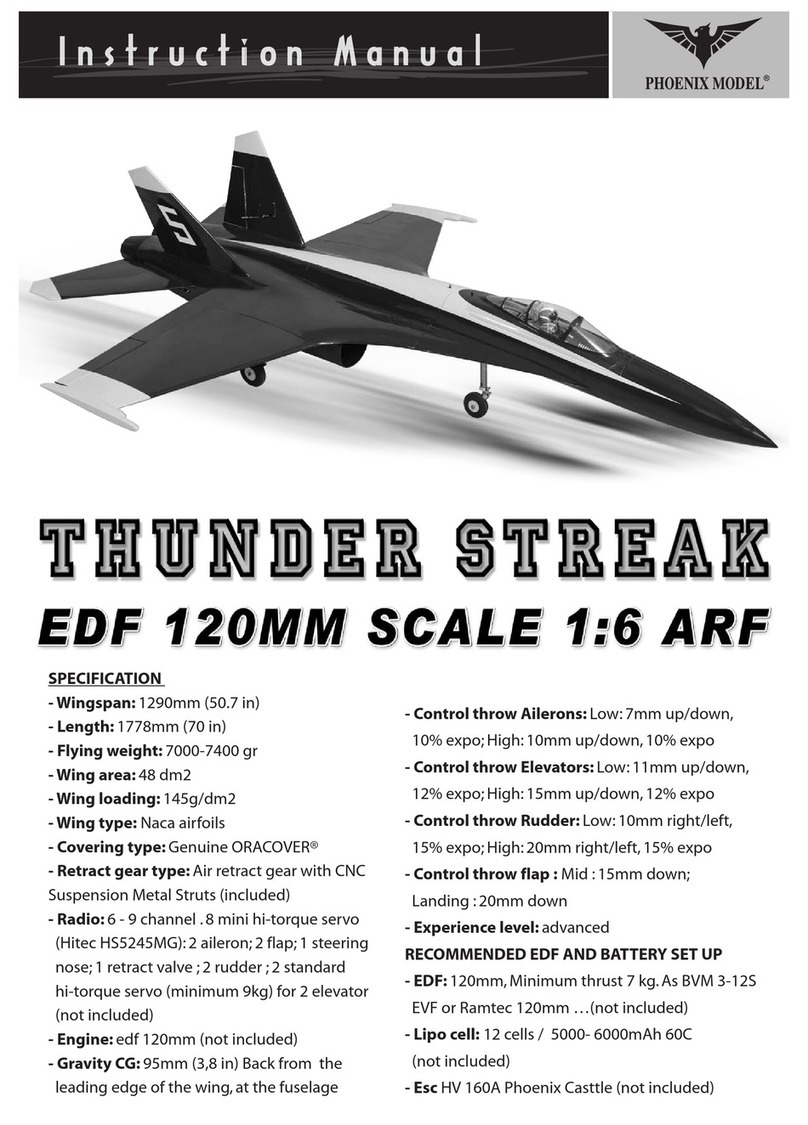
Phoenix Model
Phoenix Model Thunder Streak instruction manual
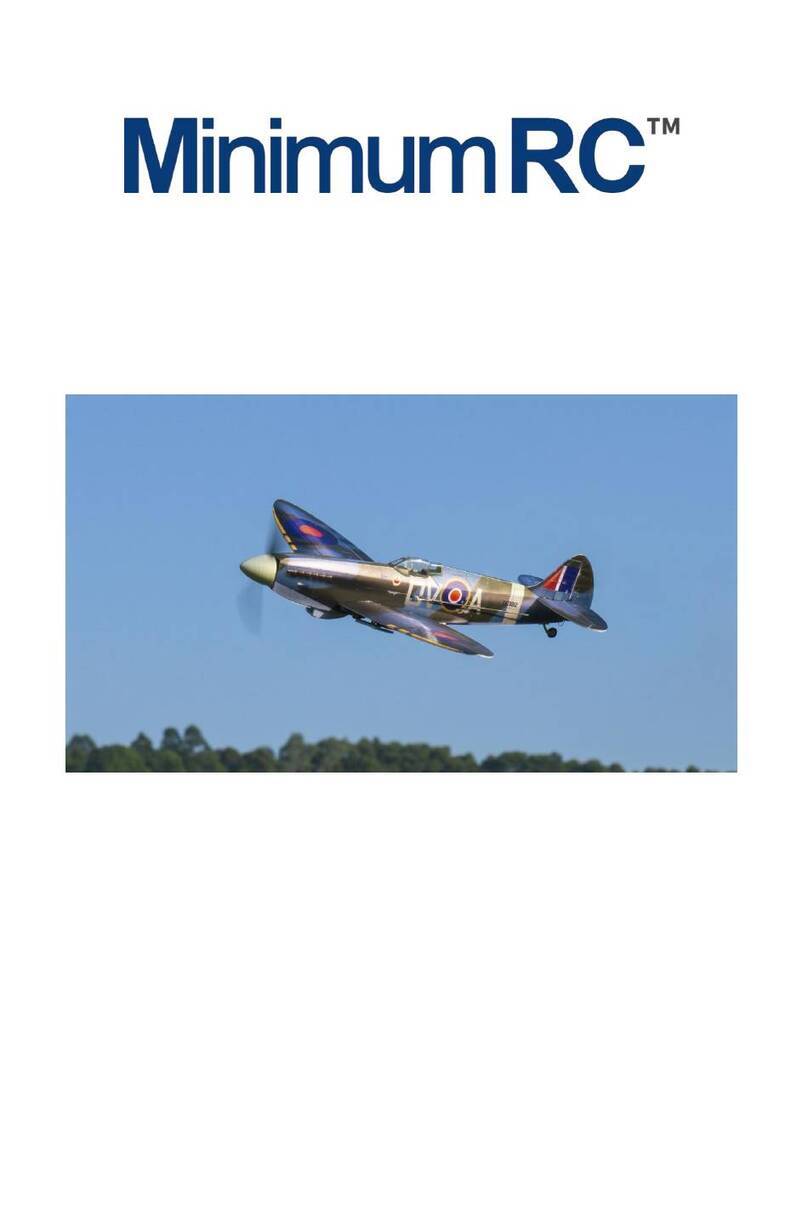
MinimumRC
MinimumRC Spitfire Assembly instructions
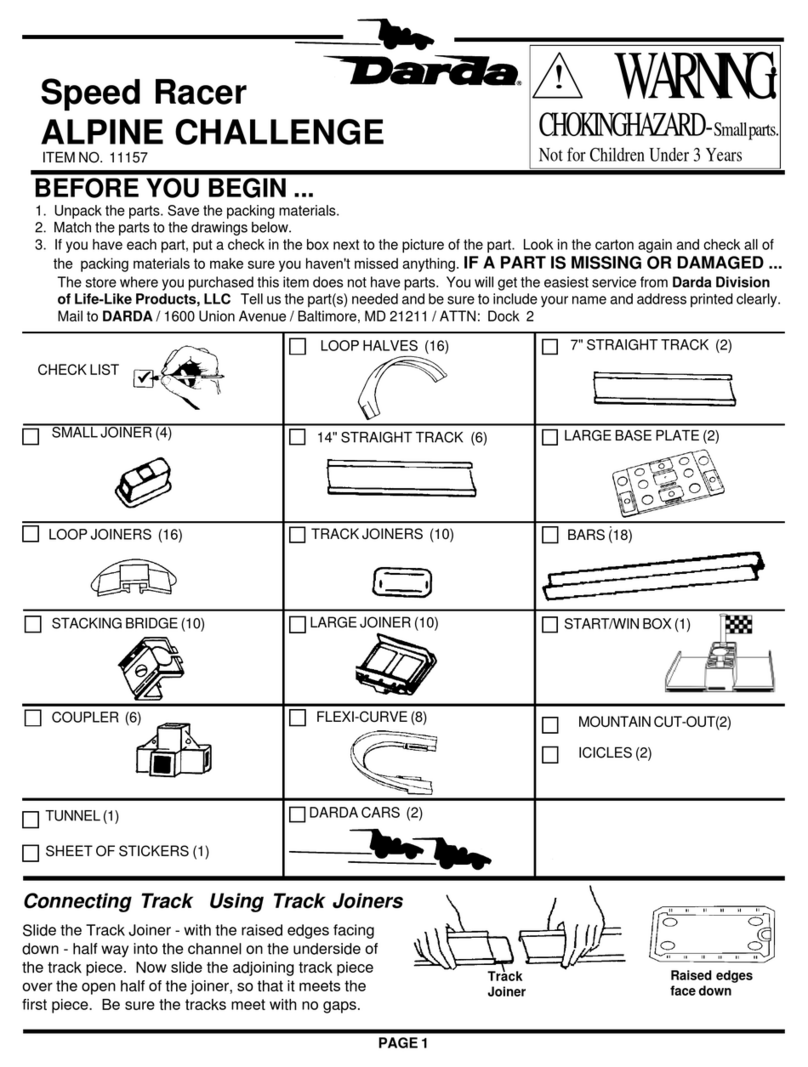
darda
darda Speed Racer ALPINE CHALLENGE quick start guide

Lionel
Lionel 2-8-4 Berkshire Locomotive and Tender owner's manual
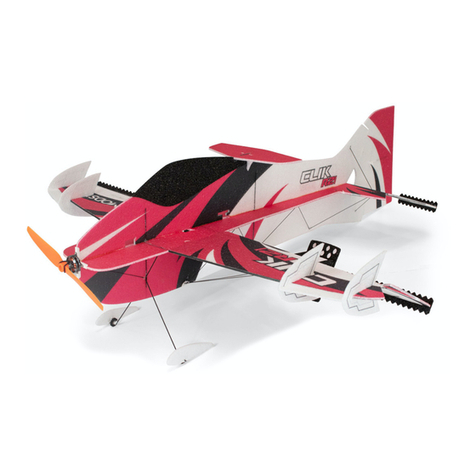
MODSTER
MODSTER CLIK R21 user manual
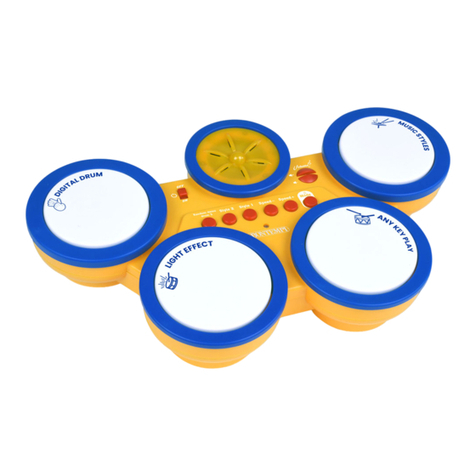
Bontempi
Bontempi HEROLIGHT 18 0535 owner's manual
